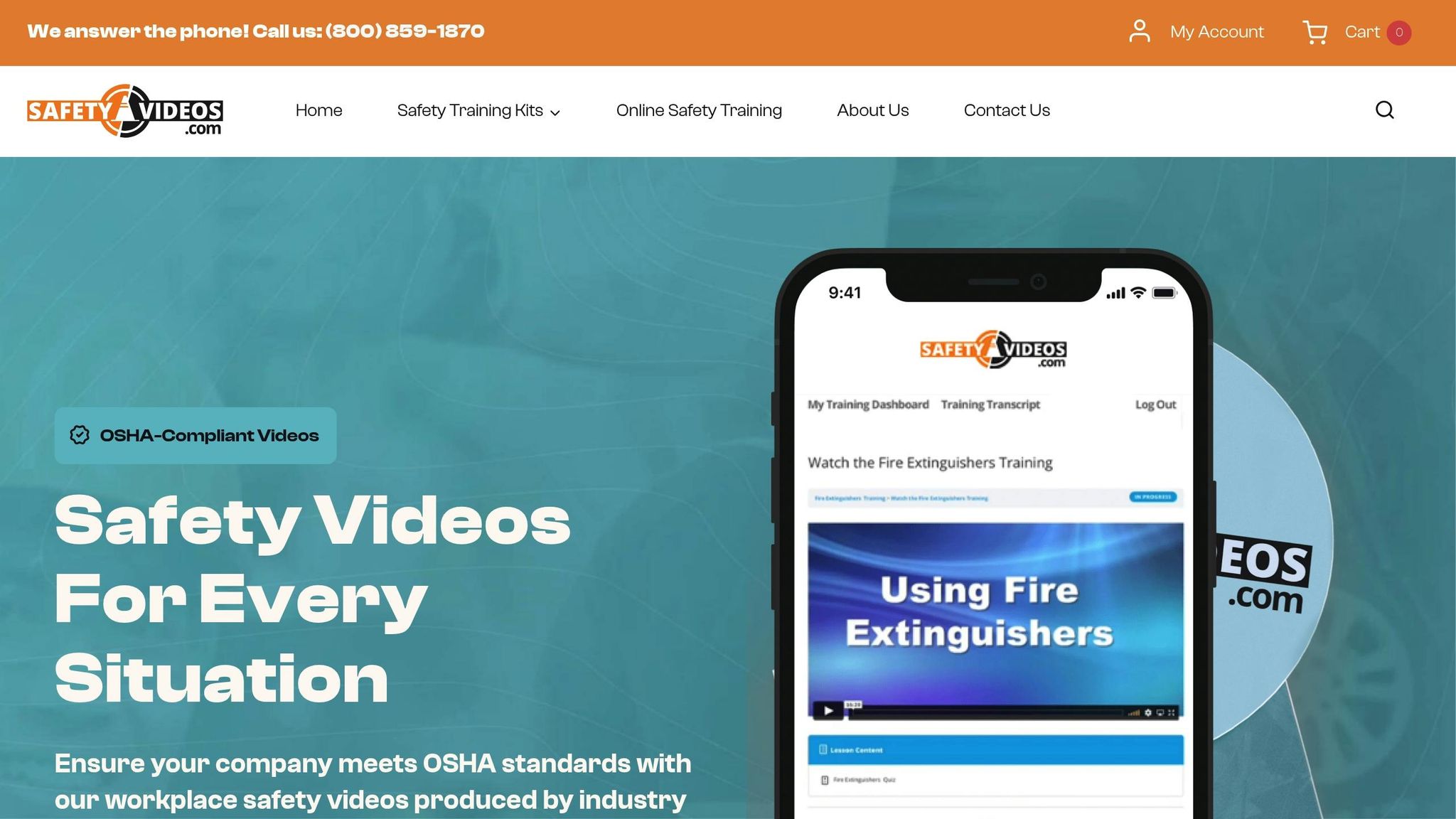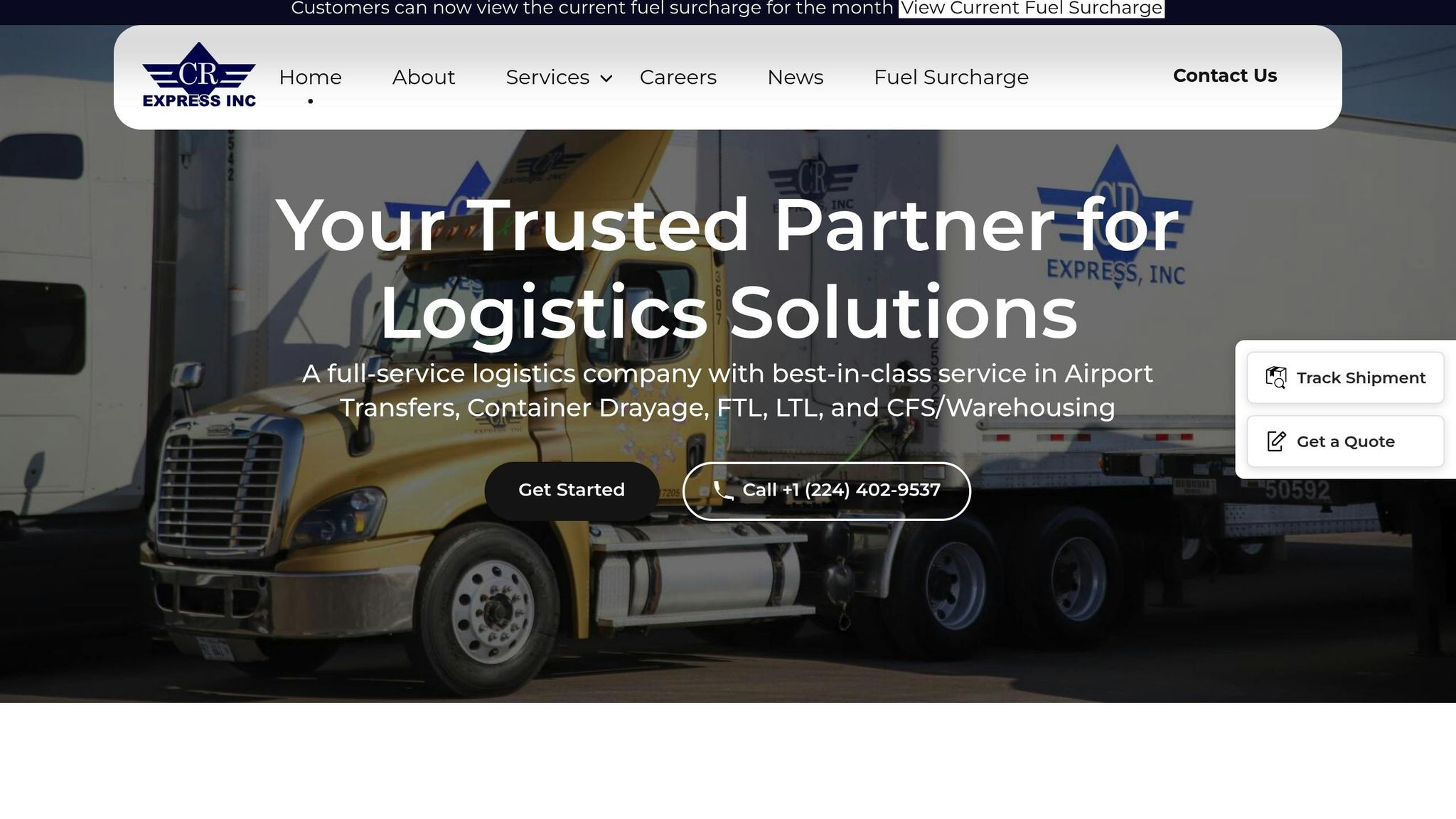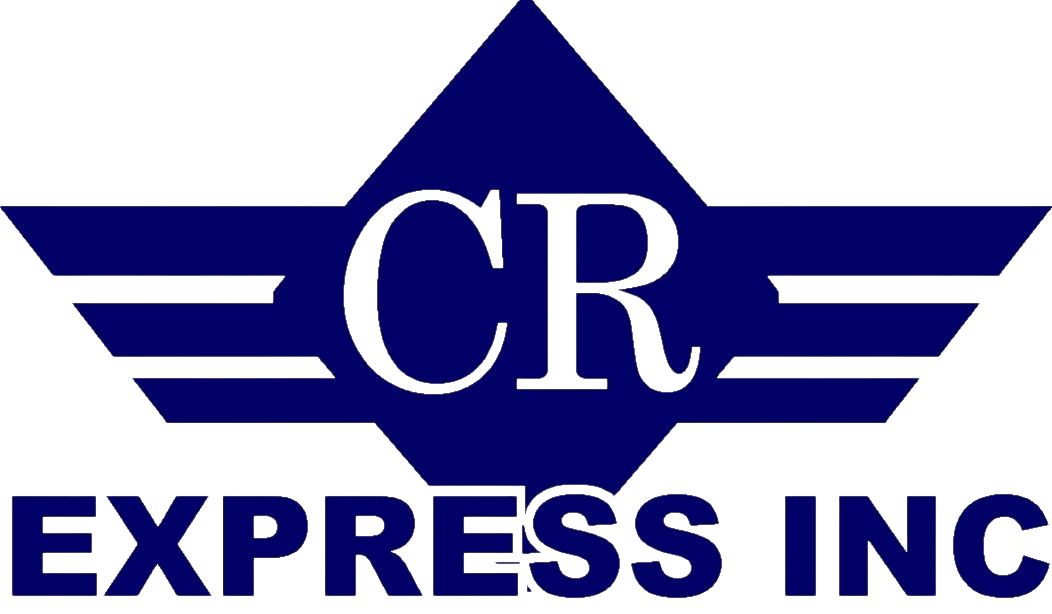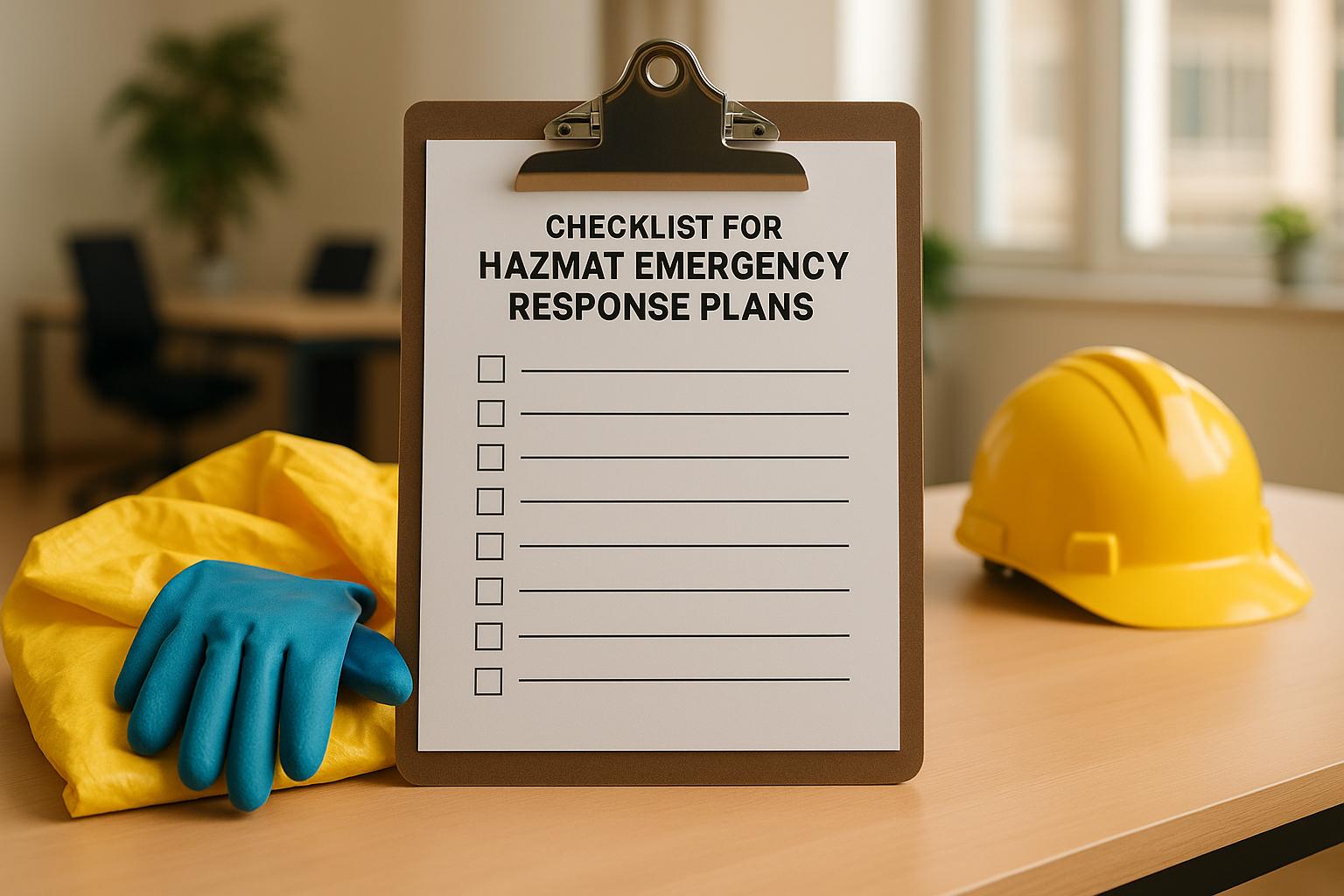If your business handles hazardous materials, a strong emergency response plan is non-negotiable. Not only does it protect your employees and community, but it’s also required by federal law. Here’s what you need to know to create an effective plan:
- Regulations to Follow: OSHA’s HAZWOPER (29 CFR 1910.120), EPCRA, and EPA’s Risk Management Program mandate safety protocols, training, and documentation.
- Key Steps: Identify all hazardous materials, maintain an up-to-date inventory, and establish clear communication and notification procedures.
- Training and Drills: Train employees annually and conduct regular drills to test and improve your plan.
- Plan Updates: Review and revise your plan after incidents or operational changes to ensure it remains effective.
- Community Collaboration: Coordinate with fire departments, EMS, and Local Emergency Planning Committees (LEPCs) to align your plan with local safety strategies.
The bottom line: A well-prepared hazmat response plan isn’t just about compliance – it’s about saving lives and minimizing risks. This guide will walk you through the essential elements to get started.
HAZWOPER Emergency Response Plan Training from SafetyVideos.com

Regulatory Requirements and Documentation
Navigating the regulatory framework is a critical step in crafting a compliant hazmat emergency response plan. Both federal and state agencies have outlined specific rules that businesses must adhere to, and proper documentation is essential – not just for emergency preparedness but also for passing inspections. Below, we’ll break down the key regulations and documentation requirements that should form the backbone of your plan.
Key Regulations to Follow
To create a compliant emergency response plan, you need to understand and follow several important regulations.
The Emergency Planning and Community Right-to-Know Act (EPCRA) is a cornerstone of federal hazmat emergency planning. Under Section 303, facilities handling extremely hazardous substances are required to develop detailed emergency response plans and submit them for regulatory review. This law impacts over 13,000 facilities across the country. Complementing this is OSHA’s HAZWOPER standard (29 CFR 1910.120), which establishes safety protocols for hazardous waste operations and emergency response. This standard requires facilities to implement an onsite incident command system, provide specialized employee training, and maintain thorough emergency documentation.
Further oversight comes from the EPA’s Risk Management Program (RMP) and DOT regulations, particularly for facilities involved in transporting hazardous materials. In 2023 alone, the DOT reported over 16,000 hazardous materials incidents, underscoring the importance of these stringent planning and documentation requirements.
At the state level, additional regulations often come into play. Many states require annual reviews of emergency plans and impose extra documentation standards, particularly for notification procedures and training records. These requirements vary widely, so it’s essential to consult your State Emergency Response Commission (SERC) to ensure local compliance.
Required Emergency Contacts and Plan Documentation
Regulations also dictate specific elements that must be included in your emergency response plan. For starters, you’ll need to designate facility and community emergency coordinators, complete with their current names, titles, phone numbers, and email addresses. This information must be reviewed and updated at least once a year or whenever personnel changes occur.
Your plan should also identify all facilities within your planning district that are subject to EPCRA and include detailed transportation routes for extremely hazardous substances. For example: "Primary route: Interstate 70 eastbound; Secondary route: State Route 12 northbound". These route details are crucial for helping emergency responders anticipate and prepare for potential incidents.
Clear notification procedures are another must. Your plan should outline how to quickly notify officials and the public during an emergency, including the use of reliable communication systems that can operate under crisis conditions. Many facilities are now adopting digital notification systems and real-time data-sharing tools to enhance accuracy and response speed.
Once your plan is complete, it must be submitted to the SERC and your Local Emergency Planning Committee (LEPC) for review and approval. This submission should occur when the plan is first developed and whenever significant updates are made, such as changes in operations, chemicals stored, or key personnel. LEPCs are instrumental in reviewing plans, ensuring compliance, and working with facilities and local responders to address community risks.
Finally, your documentation should include a thorough inventory of emergency equipment and facilities, evacuation and shelter-in-place plans, and training schedules for emergency response personnel. A good practice is to store digital copies in secure, access-controlled systems while keeping hard copies in locations known to emergency coordinators.
For businesses managing specialized hazardous shipments, CR Express offers tools and services to support compliant documentation and emergency planning.
Hazard Identification and Risk Assessment
Once you’ve established your regulatory framework, the next step is to identify hazardous materials and evaluate their risks. This step is the backbone of your emergency response plan. After all, you can’t effectively prepare for emergencies if you don’t fully understand what could go wrong or where the vulnerabilities lie. A thorough risk assessment sets the stage for a well-prepared response.
Creating a Hazardous Materials Inventory
Building a detailed inventory of hazardous materials is more than just jotting down a list of chemicals – it’s about capturing every piece of information that could be critical during an emergency.
Start by cataloging all hazardous substances at your facility. For each item, document key details like the chemical name, common name, quantity, concentration, and exact storage location. Include the type of container – whether it’s a drum, tank, or specialized storage unit – since this can influence how you respond in an emergency.
Chemical properties are especially important. Record specifics such as boiling points, flash points, toxicity levels, and regulatory identifiers like CAS numbers and DOT hazard classifications. For example, one manufacturing facility discovered that two chemicals stored near each other could react dangerously if combined during an emergency. By identifying this risk, the company relocated the materials to safer, separate areas, preventing potential disaster.
Safety Data Sheets (SDS) are essential tools in this process. These documents provide detailed information about each material’s properties, emergency contacts, and specific response steps. Keep your SDS records current and easily accessible, updating them as needed.
Additionally, include regulatory classifications from agencies like the EPA, OSHA, and DOT in your inventory. These classifications guide your emergency procedures and help first responders quickly understand the risks. For instance, a DOT Class 3 flammable liquid requires a different response approach than a Class 8 corrosive substance.
Regular updates to your inventory are crucial. Aim to review it annually or whenever significant changes occur, such as new materials being introduced or processes being modified. Assign dedicated personnel to oversee this task and consider using digital tracking systems to maintain accuracy and ensure quick access during emergencies.
Evaluating Local and Environmental Risks
Once your inventory is complete, shift focus to assessing how these hazards interact with the local environment and community. This step ensures that your emergency plans address both internal risks and external impacts.
Start by mapping your facility and the surrounding area, typically within a 1–2 mile radius depending on the materials you handle. Identify sensitive locations nearby, such as hospitals, schools, daycare centers, senior living facilities, residential neighborhoods, and critical infrastructure like water treatment plants or power stations.
Pay close attention to transportation routes used for hazardous material shipments. Document primary and secondary routes, noting any sensitive areas along the way. For example, if your trucks pass by an elementary school during peak hours, this timing and location should factor into your emergency notification and response plans.
Environmental factors can significantly influence the severity of an incident. Consider prevailing wind patterns that could spread vapors or smoke toward populated areas, as well as drainage systems that might carry spills into water sources or storm drains. Population density is another key factor – a release in a sparsely populated rural area poses different challenges than one in a densely packed urban setting.
Leverage tools like the EPA’s CAMEO software suite to model potential impact zones for various scenarios. Historical data and resources such as the Emergency Response Guidebook can also provide valuable insights into hazard distances and response recommendations.
Collaborate with your Local Emergency Planning Committee (LEPC) to address community-specific risks. These committees can help identify vulnerabilities, recommend evacuation routes, and align your plans with broader community emergency strategies.
Don’t overlook natural and man-made hazards that could exacerbate a hazardous materials emergency. Events like floods, tornadoes, earthquakes, train derailments, or utility failures can escalate a situation quickly. Your risk assessment should account for these possibilities and how they might affect your response capabilities.
For businesses managing complex hazardous shipments, partnering with specialized logistics providers like CR Express can bring added expertise. Their experience in hazardous material transportation can help pinpoint risks and craft effective mitigation strategies.
Finally, keep your risk assessment up to date. Schedule annual reviews at a minimum and reassess whenever there are major changes to your inventory, facility layout, or transportation routes. By staying proactive, you can refine your emergency response procedures and reduce the likelihood of incidents.
sbb-itb-c0b8770
Emergency Response Procedures
Once you’ve completed a thorough hazard assessment and ensured compliance with regulations, the next step is creating response procedures that enable quick and effective action during hazardous material (hazmat) emergencies. These procedures are critical for maintaining control when every moment counts.
Step-by-Step Response Procedures for Incidents
A well-designed hazmat emergency response plan includes clear, scenario-specific steps tailored to the risks identified in your assessment. Whether dealing with a minor spill or a large-scale release that could impact nearby communities, these steps should leave no room for confusion.
Start by defining immediate actions: recognize the incident, isolate the affected area, and notify the emergency coordinator. Include clear instructions for identifying the hazardous substance involved. This may involve checking container labels, consulting Safety Data Sheets (SDS), or observing physical characteristics. Correct identification is crucial – it informs every decision that follows.
Quick notification protocols are a must. Assign both facility and community emergency coordinators who are authorized to implement the emergency plan. These coordinators should be trained extensively in hazmat response, incident command systems, and communication protocols. Their responsibilities include deciding when to fully activate the emergency plan, coordinating with local responders, ensuring timely notifications, and managing evacuation or decontamination efforts.
Set up reliable notification methods, such as predefined contact lists and real-time alert systems, to quickly inform officials, emergency services, and the public.
Containment and mitigation strategies must be clearly outlined for various types of releases. If a spill occurs, use resources like the Emergency Response Guidebook to identify hazards and initiate containment. Include guidance on when it’s safe to attempt containment and when evacuation is the safer option while waiting for specialized responders.
Assessment procedures should focus on determining the affected area’s size using hazard modeling tools or reference materials like the Emergency Response Guidebook. Consider factors such as wind direction, population density, and proximity to sensitive locations like schools or hospitals. Detection methods might include fixed sensors, visual inspections, or employee reporting protocols.
For businesses handling complex hazardous shipments, working with specialized logistics providers like CR Express can offer added expertise. These providers can assist with regulatory compliance, route risk assessments, and emergency response planning. They can also provide training for drivers and handlers, ensuring a higher level of preparedness.
Once these incident response protocols are in place, the next priority is establishing clear evacuation and decontamination procedures.
Evacuation and Decontamination Procedures
Evacuation plans should include well-defined routes, assembly points, and measures for personnel accountability. For situations where evacuation isn’t feasible, implement shelter-in-place strategies. These should detail how to seal ventilation systems and identify the safest areas within the facility.
The decision to evacuate or shelter in place depends on several factors, including the type of hazardous material, weather conditions, and the release’s proximity to populated areas. For example, if a leak occurs near a residential neighborhood, your plan should guide responders in quickly identifying the vulnerable zone and initiating protective actions.
Decontamination procedures need to address people, equipment, and the environment. Establish decontamination zones, specify the necessary personal protective equipment (PPE), and outline disposal methods.
For personnel, the steps should vary depending on the type of exposure. In cases involving corrosive chemicals, include the use of emergency showers and eye wash stations. Provide protocols for removing contaminated clothing, flushing affected skin or eyes, and determining when medical attention is required. Follow-up medical evaluations should also be part of the plan.
Equipment and environmental decontamination procedures should cover cleaning tools, vehicles, and handling soil or water contamination. Specify which cleaning agents to use for different substances, how to test for residual contamination, and when to engage specialized cleanup contractors.
Keep an inventory of emergency equipment and resources available both onsite and within the community. This should include decontamination supplies, PPE, containment materials, and communication devices. Ensure that your team knows how to access additional resources if needed.
Regular coordination with your Local Emergency Planning Committee (LEPC) is vital. LEPCs provide support, resources, and expertise for hazmat preparedness. By participating in LEPC meetings, sharing hazard information, and joining joint training exercises, you can align your evacuation and decontamination procedures with broader community strategies. This collaboration ensures that local fire departments, hospitals, and other resources are ready to assist during an emergency.
Finally, remember that these procedures are not static. Regular testing and updates are essential. At a minimum, conduct annual reviews and reassess whenever there are significant changes to your operations, the chemicals you handle, or your facility layout. Over the past decade, better planning and prevention have contributed to a steady decline in chemical accidents at Risk Management Program (RMP) facilities.
Training, Drills, and Plan Updates
An effective hazmat emergency plan goes beyond just being written down – it needs to be actionable. The ability of your team to execute the plan hinges on regular training, realistic drills, and consistent updates. These elements not only ensure compliance with federal regulations but also safeguard your workforce. Here’s how to build and maintain a solid preparedness program.
Training for Employees and Emergency Responders
Under OSHA’s HAZWOPER standard (29 CFR 1910.120), employers must provide role-specific training for any employees working with hazardous materials. This includes both initial training and annual refreshers. Tailoring the training to fit specific roles is crucial for its effectiveness.
Key topics should include hazard recognition, safe chemical handling, proper use of personal protective equipment (PPE), emergency notification protocols, and the incident command system (ICS). For example, warehouse staff should focus on spill containment and evacuation procedures, while drivers need specialized training for transportation emergencies and roadside response.
Maintaining detailed training records is not just a best practice – it’s a compliance requirement.
Collaboration with local emergency responders is also critical and mandated under the Emergency Planning and Community Right-to-Know Act (EPCRA). Schedule annual coordination meetings with local fire departments, hazmat teams, and emergency medical services. During these meetings, share information about the chemicals your facility handles, the layout of your building, and access points for emergency vehicles.
Joint training exercises with these responders can reveal communication gaps and clarify roles during an actual emergency. For instance, your emergency coordinator should know how fire departments prefer to receive hazard information, while local responders need a clear understanding of your evacuation routes and assembly points.
Testing and Updating Your Plan
Training lays the groundwork, but testing your plan and keeping it updated are just as important. Federal guidelines require regular testing of emergency response plans through drills and exercises. The EPA advises conducting at least one full-scale exercise annually, supplemented by more frequent tabletop exercises and functional drills.
Testing methods like tabletop exercises, functional drills, and full-scale simulations help identify weaknesses in your plan. Semi-annual drills reinforce response procedures, while full-scale simulations can highlight gaps in communication or resource allocation.
After each drill or real-life incident, conduct a thorough review with all participants. Document successes, identify what needs improvement, and make specific adjustments to your plan. This process ensures continuous refinement of your emergency response strategies.
Updates to your plan should follow whenever gaps are identified, incidents occur, or significant operational changes take place. Common triggers for updates include changes in hazardous materials, facility layouts, key personnel, or local emergency response capabilities.
Regular drills and systematic updates not only enhance preparedness but also increase the likelihood of passing compliance audits and effectively managing real emergencies. Treat your emergency response plan as a dynamic document that evolves with your operations and incorporates lessons learned from both drills and actual events.
Keep detailed records of all training sessions and drills. Comprehensive documentation demonstrates your commitment to improvement and helps during regulatory audits.
Outdated plans and poor record-keeping are among the most frequent compliance issues. Even if no major changes occur, schedule an annual review of your entire plan to ensure it remains current and effective.
For businesses managing complex hazardous shipments, working with specialized logistics providers like CR Express can be a game-changer. These providers bring expertise in hazmat transportation protocols and often offer additional training resources for drivers and handlers involved in hazardous materials transport.
Next Steps for Your Emergency Response Plan
Main Points from This Checklist
To ensure your hazmat plan is up to standard, it must address key areas: identifying hazards, establishing clear response protocols, and prioritizing community safety. Start by maintaining an up-to-date inventory of all hazardous materials onsite.
Assign emergency coordinators and create dependable notification systems for both internal teams and external responders. Your plan should also detail how to quickly detect material releases and assess the areas impacted.
Include step-by-step procedures for incidents occurring both onsite and during transportation. These should cover evacuation routes, decontamination steps, and access to medical care.
Stay in sync with local emergency services by holding regular meetings with fire departments, hazmat teams, and Local Emergency Planning Committees (LEPCs). This collaboration ensures everyone is on the same page when it matters most.
Training and testing programs are essential to keep your plan effective and your team prepared. For instance, facilities governed by the Risk Management Program are required to conduct exercises, such as tabletop drills, between 2023 and 2026, based on their specific risk levels.
During reviews, common gaps often include outdated emergency contact lists, incomplete hazard inventories, limited coordination with local responders, and missing records of drills or updates. For example, a manufacturing facility in Texas used a detailed checklist to audit its emergency response plan. By updating contact information and conducting additional training, they improved readiness and passed a subsequent regulatory inspection.
Once your internal systems are in place, bringing in external support can further strengthen your preparedness.
How CR Express Can Help

Managing hazardous materials effectively isn’t just about having a solid emergency plan – it also requires reliable logistics expertise. That’s where CR Express steps in, leveraging 26 years of experience in handling hazardous shipments to complement your emergency response strategy.
Their TSA-approved transportation services and certified CFS solutions ensure hazardous materials are securely stored and transported, reducing the chances of incidents that could activate your emergency plan.
CR Express also offers bonded warehousing for compliant hazardous material storage. Their 280,000-square-foot facility near O’Hare Airport is equipped with specialized areas for hazardous, high-value, and temperature-sensitive goods. With full-coverage CCTV and secured loading docks, they provide peace of mind for businesses needing secure storage solutions. Additionally, their Good Distribution Practice (GDP) compliance for pharmaceutical and healthcare logistics underscores their commitment to meeting regulatory standards.
For companies revising their hazmat plans, CR Express provides actionable insights and logistics support tailored to your needs. Their expertise in customs compliance and integrated supply chain solutions ensures your emergency plan aligns with current regulations.
With a strategic location near O’Hare Airport and access to 21 Chicagoland railyards, CR Express offers quick response capabilities when logistics support is critical. Their specialized knowledge and geographic advantage make them a trusted partner for businesses aiming to enhance their emergency preparedness.
FAQs
What are the key regulations businesses must follow when developing a hazmat emergency response plan?
To develop a hazmat emergency response plan that meets regulatory standards and works effectively, businesses must follow guidelines set by agencies like the U.S. Department of Transportation (DOT) and the Occupational Safety and Health Administration (OSHA). These regulations typically include the following key components:
- Hazard Classification: Accurately identifying and categorizing hazardous materials according to DOT standards.
- Emergency Contact Information: Ensuring round-the-clock access to emergency response contacts and necessary resources.
- Employee Training: Providing OSHA-required training to employees on safely handling and responding to hazardous materials incidents.
- Documentation: Keeping detailed and up-to-date shipping papers and safety data sheets (SDS) for all hazardous material shipments.
It’s also important for businesses to routinely review and update their emergency response plans to account for regulatory changes or shifts in operations. Working with an experienced logistics provider like CR Express, which specializes in transporting hazardous materials, can simplify compliance efforts and improve the overall planning process.
How often should businesses update their hazmat emergency response plans, and what events might require a review?
Businesses should revisit and revise their hazmat emergency response plans at least once a year. This routine check ensures the plan aligns with current regulations and reflects the latest industry standards. Regular updates also help account for any changes in operations, team structure, or potential risks.
Beyond the annual review, certain situations might demand an immediate update, including:
- Regulatory updates that affect how hazardous materials are handled or transported.
- Operational shifts, such as adopting new routes, equipment, or types of shipments.
- Incidents or close calls involving hazardous materials that highlight areas for improvement.
- Changes in personnel, which may require adjustments to roles or responsibilities within the plan.
Being proactive with these updates keeps your emergency response plan both effective and compliant. For businesses managing hazardous shipments, collaborating with a reliable logistics partner like CR Express can make a significant difference. They specialize in hazmat transportation and safety compliance, offering expertise to help you navigate these challenges with confidence.
How do local emergency services and community organizations support a company’s hazmat emergency response plan?
Local emergency services and community organizations are key players in bolstering a company’s hazmat emergency response plan. Their expertise, resources, and ability to coordinate during hazardous material incidents are invaluable in reducing risks and safeguarding public safety.
Building partnerships with these groups can lead to quicker response times, access to specialized tools, and better communication during critical moments. Working together through joint training sessions and aligning safety protocols not only boosts preparedness but also helps meet local regulatory requirements.





